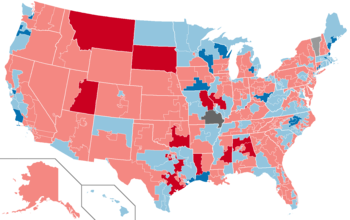United States House of Representatives elections, 1996
|
|
||||||||||||||||||||||||||||||||||||||||||||
|
||||||||||||||||||||||||||||||||||||||||||||
|
||||||||||||||||||||||||||||||||||||||||||||
|
|
||||||||||||||||||||||||||||||||||||||||||||
|
Results:
Democratic hold
Democratic pickup
Republican hold
Republican pickup
Independent hold
Independent pickup
|
||||||||||||||||||||||||||||||||||||||||||||
|
||||||||||||||||||||||||||||||||||||||||||||
The 1996 United States House of Representatives elections was an election for the U.S. House of Representatives on November 5, 1996, which coincided with the re-election of Bill Clinton as President of the United States. Clinton's Democratic Party won by almost 60,000 votes (0.07%) and gained a net of two seats from the Republican Party, but the Republicans retained an overall majority of seats in the House for the first time since 1928. The election is similar to the 1952 midterm elections, although, in terms of the total vote this result remains one of the closest in U.S. history.
40 incumbents retired: 29 Democrats and 21 Republicans, giving the Republicans a net gain of 6 seats from the Democrats.
21 seats switched parties in the November elections, giving the Democrats a net gain of 15 seats from the Republicans.
...
Wikipedia



